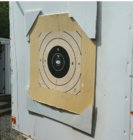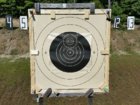I have no doubt the NRA is going to have to rely on help from the folks developing this technology in order to come up with anything meaningful as far as test criteria goes. Judging from the current version of ShotMarker, I'd have to say it sure looks like it was thoroughly evaluated for accuracy of the results, and I wouldn't be surprised if Adam had some thoughts on the subject... same with the Hexta and Silver Mountain guys.
The back and forth discussion on 'acoustic center' and 'calibration' may have left some confused and questioning the suitability of e-targets in competition settings, so I thought an e-target screenshot along with a photo of the actual target might be useful for understanding why having an acoustic center that corresponds exactly with the center of the target isn't essential for accurate scoring.
First, the ShotMarker screenshot...
View attachment 1101500
...and the paper target that provided the aiming point.
View attachment 1101501
Notice the correspondence is very close, but not exact, and indicates the acoustic center of the ShotMarker is ever so slightly high and maybe a hair left (S2 and 3, illustrate this well). But even if acoustic center had been off by a larger margin, the same score would've been registered, assuming the shooter compensated accordingly (i.e. "My shots are landing high, thus I need to aim lower.").
Excellent Post,
Great illustration of how that system is every bit good enough for what we do in United States of America; Sanctioned NRA and CMP Matches.
If I were in the market for an E Target for myself or my club and I only read this thread for my research I would think no E Targets could be trusted..
I would also think they are very complicated and difficult to set up and use by the average person or Match Director..
With over 1000 ShotMarkers sold in the 1st year and around 600 Solo's that is obviously not the case.
In this thread I am also often confused about what systems and vintage of technology is being discussed in most of the posts.
There will always be the few (some anonymous) that greatly enjoy discussing the minutia of the science into eternity. There is nothing wrong with that and if they enjoy that better than shooting more power to them - imo.
The DOWN SIDE of all this tecchy discussion it is it RAISES DOUBTS about the "Current" technology for many,,,,, while many of us others will be out on the range enjoying the benefits that E targets provide them.
Many new NRA National Records were just shot on open sensor targets down at the Orange Blossum Regional in Florida. http://www.orangeblossomregional.com/match-scores/
When the commitment is made by a club to go to E targets and once the match is underway all that matters and all the shooters make sight corrections off of is what they see on the tablet.
What shows up for shot value on the tablets is all that matters...
Nobody will be in the pits checking each shot and the targets will not be sent out to NASA to compare what is on the dry or wet paper targets that were blowing around in the wind that day.
All on the range that day will have shot under the same conditions. The better shooters that most often won on paper targets will still win on E Targets. Just like at OBR recently where the new National records were shot.
Cheers,
See you on the range
George
Last edited:












